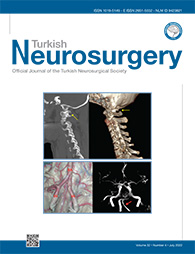2Private OFM Antalya Hospital, Department of Neurosurgery, Antalya, Turkey
3Katip Celebi University Ataturk Training and Research Hospital, Department of Neurosurgery, Izmir, Turkey
4Dokuz Eylul University Heath Science Institude, Department of Biomechanics, Izmir, Turkey
5Abdulhamid Han Training and Research Hospital, Department of Neurosurgery, Istanbul, Turkey
6Osmangazi University School of Medicine, Department of Neurosurgery, Eskisehir, Turkey
7Dokuz Eylül University School of Medicine, Department of Orthopedics and Traumatology, Izmir, Turkey DOI : 10.5137/1019-5149.JTN.35526-21.3 AIM: To investigate the pullout strength of a pedicle screw reinserted through the same trajectory
MATERIAL and METHODS: Fifty freshly frozen lamb L4 vertebrae were divided into the following five groups: Group 1, inserted with a 5-mm pedicle screw; Group 2, inserted with a 5-mm pedicle screw followed by the removal and reinsertion of the same screw after control; Group 3, inserted with a 5-mm pedicle screw followed by the removal and reinsertion of a 5.5-mm screw after control; Group 4, inserted with a 5.5-mm pedicle screw; and Group 5, inserted with a 5.5-mm pedicle screw followed by the removal and reinsertion of the same screw after control. Pedicle screws were inserted into the right pedicles, and axial pullout testing was performed at 5 mm/min. All data were recorded. A load-displacement curve was used to obtain the peak value of the pullout strength for all specimens.
RESULTS: The mean pullout strengths were 1086.22 N, 1043.32 N, 1039.18, 1199.10, and 1131.68 N for Groups 1?5, respectively. No significant difference was observed among all groups (p>0.05).
CONCLUSION: Perioperative reinsertion of the same screw or (0.5 mm) larger in diameter through the same trajectory after the control of the screw trajectory did not affect the pullout strength of the screw.
Keywords : Biomechanics, Lumbar vertebrae, Pedicle screw, Tensile Strength




